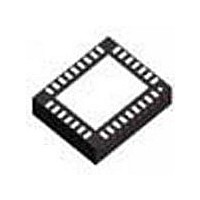LM4918LQ/NOPB National Semiconductor, LM4918LQ/NOPB Datasheet - Page 12

LM4918LQ/NOPB
Manufacturer Part Number
LM4918LQ/NOPB
Description
IC AMP AUDIO PWR 1.1W STER 32LLP
Manufacturer
National Semiconductor
Series
Boomer®r
Type
Class ABr
Datasheet
1.LM4918LQNOPB.pdf
(17 pages)
Specifications of LM4918LQ/NOPB
Output Type
2-Channel (Stereo)
Max Output Power X Channels @ Load
1.1W x 2 @ 8 Ohm
Voltage - Supply
2.7 V ~ 5.5 V
Features
Depop, Mute, Shutdown, Thermal Protection, Volume Control
Mounting Type
Surface Mount
Package / Case
32-LLP
Operational Class
Class-AB
Audio Amplifier Output Configuration
2-Channel Stereo
Output Power (typ)
1.1x2@8OhmW
Audio Amplifier Function
Speaker
Total Harmonic Distortion
0.3@8Ohm@1W%
Single Supply Voltage (typ)
3/5V
Dual Supply Voltage (typ)
Not RequiredV
Power Supply Requirement
Single
Rail/rail I/o Type
No
Power Supply Rejection Ratio
67dB
Single Supply Voltage (min)
2.7V
Single Supply Voltage (max)
5.5V
Dual Supply Voltage (min)
Not RequiredV
Dual Supply Voltage (max)
Not RequiredV
Operating Temp Range
-40C to 85C
Operating Temperature Classification
Industrial
Mounting
Surface Mount
Pin Count
32
Package Type
LLP EP
Lead Free Status / RoHS Status
Lead free / RoHS Compliant
Other names
LM4918LQ
www.national.com
Application Information
AUTOMATIC GAIN CONTROL (AGC)
The AGC represents a closed loop gain control network in
conjunction with the peak detect monitoring the outputs of
the power amplifier section. A reference voltage is put on the
“AGC Ref In” pin to set the desired dynamic range of the
AGC. This voltage should be set to allow for maximum
desired output level for the expected range of the input
signal. The AGC may provide anywhere from 0 to 24dB of
attenuation. The peak detect constantly updates the AGC
block with information about the maximum level of the output
signal. Internally, if this peak value is higher than the set
reference voltage, the AGC will reduce the gain of the circuit
until the output peak is lower than the reference voltage. This
entire process is timed by the Chold capacitor (in conjunction
with Rdischarge), which determines the hold time between
peaks while restoring gain (gain returns to normal levels
after being attenuated by large power amp output signal).
The circuit shown in Figure 3 best describes the AGC loop
operation. Square nodes are external pins. Vbp is the by-
pass voltage. As is shown below, the peak detect section
(PD) monitors all outputs of the power amp (VoL+, VoL-,
VoR+, and VoR-). Peaks are fed into the peak buffer, regu-
FIGURE 3. Block Diagram with external component for AGC closed loop
(Continued)
12
lated by Chold and Rdis. The output of the peak buffer
(VpkBfr) is then compared to VagcRef. The AGC amplifier
then sets the ADC output to control the gain setting in 32
discrete steps from 0 to –24dB. Gain will remain reduced
until peak levels (Vpkbfr) return below the VagcRef, as buff-
ered by the peak buffer and Chold. This means gain will
slowly increase (speed determined by Chold) back to normal
levels (maximum gain set) or until the peaks again exceed
the reference level.
The reference voltage VagcRef should be set in conjunction
with the gain settings on the power amplifier stage to provide
maximum gain (0dB) for the typical desired maximum output
level of the part for a maximum input level. This will ensure
that both the full 24dB dynamic range of the AGC is used
effectively and that maximum effective audio levels may be
reached without clipping. Typical AGC peak gain values for
given VagcRef voltages are shown in Table 1. These are
taken with a 20MΩ pullup resistor on Chold (as used shown
on the demo board). These are shown as typical values only
– VagcRef level should be set with the factors described
above.
200913E7







